06.07.2022
WordPress Development
Headless WordPress for Omnichannel eCommerce
READING TIME: MIN
Table of Content
Being able to provide an innovative digital experience for customers is an absolute MUST for eCommerce businesses. Retail brands are beginning to realise that legacy eCommerce platforms are holding them back due to their inability to provide advanced solutions that can keep up with the fast-paced and ever-changing digital landscape.
So what can retail companies do to ensure they’re not falling behind and are actually staying ahead of the game? We believe embracing the headless architecture approach and offering customers an unmatched omnichannel experience is the way to go.
Our Headless WordPress agency knows that both sellers and consumers can benefit greatly from synchronising sales channels. Remember that the modern-day customer is getting more and more selective with the brands they choose to shop from online. Nowadays, people browsing the net want immediate access to information, prompt action, and offers that are specifically suited to their unique demands.
This is where the omnichannel strategy steps into the picture, assisted by a CMS with headless architecture. This innovative approach to web development can help brands meet and exceed their customers’ expectations. What’s more, the headless architecture can significantly improve the internal management of an omnichannel eCommerce business.
In this article, we’ll discuss how investing in a Headless WordPress development can aid eCommerce businesses in streamlining omnichannel experiences. Read on to learn how to stay one step ahead of the competition and drive greater innovation to your online business!
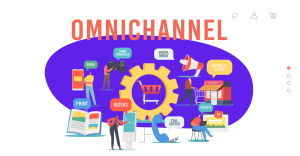
What Does Omnichannel Mean?
The term “omnichannel” refers to a multichannel sales strategy that aims to give customers a smooth shopping experience whether they’re making purchases online, over the phone, or in a physical store.
With an omnichannel approach, there is a back-end integration of distribution, promotion, and communication channels. Here’s what an omnichannel experience might look like:
For instance, a customer can use a desktop computer to browse the inventory of a brand’s online store. Then, the customer can choose to purchase an item with their smartphone or tablet. Lastly, the customer can pick up the product they purchased at a preferred physical location.
Our Headless WordPress agency reminds you that an omnichannel approach combines several communication channels to improve customer experience. The back-end integration of channels results in greater flexibility as the client can switch between channels through the course of interaction.
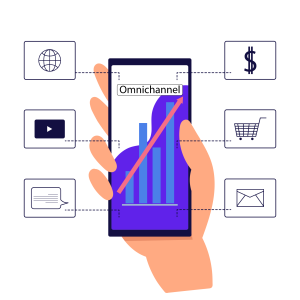
How Can Headless WordPress Solve Omnichannel eCommerce Challenges?
As you can see, an omnichannel approach to eCommerce is a rather complex endeavour. Thankfully, the headless architecture comes to the rescue, making the work of retail businesses a tad easier.
The term “headless architecture” refers to the practice of separating the front- and back- ends of a website. This is also known as a “decoupled” architecture. Our Headless WordPress agency recommends this architecture to any online business that is interested in a pick and mix functionality.
In a nutshell, headless means that you’re no longer limited to the WordPress ecosystem, and you can take advantage of custom functionality and integrations from literally anywhere. With this architecture, WordPress (in the back-end) will serve as your website’s content provider, while the front-end will serve as a distinct presentation layer. This allows you to add whatever services you want to your website.
*Want to learn more about Headless WordPress development and its indisputable benefits? Read our articles “Headless WordPress: The Future of Enterprise” and “Headless WordPress: I Choose You!” to get an in-depth understanding of this innovative approach to web development.
The headless architecture can be especially advantageous for eCommerce brands as it can help them provide incredibly distinctive shopping experiences across multiple channels. With this approach, customers get the best possible front-end shopping experience while brands connect to the same back-end processes.
When we say back-end processes, we refer to things such as enterprise resource planning (ERP), product information management (PIM), order management systems (OMS), content management system (CMS), customer database, checkout, etc. When you opt for Headless WordPress development, all of these processes remain under ITs control, meaning that they don’t require painstaking, time-consuming updates each time a front-end change is demanded.
This distinct separation of font- and back-end provides brands with more flexibility and freedom to deal with omnichannel challenges such as:
- Buy-online-pick-up-in-store (BOPIS)
- Curbside pickup
- Inventory checks
- Uniform pricing across channels
- Adding loyalty programs across all channels
- Customer interaction across different devices
Our Headless WordPress agency advises those who are considering a decoupled architecture to group capabilities together. For instance, it is best to keep everything related to checkout together. Similarly, all functions for PIM should be grouped together for maximum efficiency.
The grouping of different capabilities together can have several benefits, including:
- A single set of capabilities can be used as a test case for API-driven microservices.
- If there is just one omnichannel problem, a brand can address it immediately without having to replatform.
- Each capability set can be designated to dedicated internal teams, thus making the workflow more efficient.
- Individual capability sets can be developed and scaled independently of the others. This means that the external systems interacting with it won’t be affected in any way.
Headless WordPress development offers a myriad of advantages to eCommerce businesses, but, as with anything else, the approach comes with its own set of challenges. Remember that the headless architecture has various levels of complexity. This is why development teams may need to devote more time to debugging, communication, and integration testing among microservices.
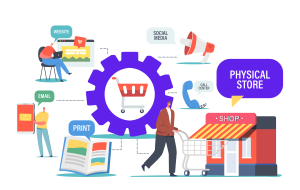
How to Make the Leap Toward Headless?
The demand for greater eCommerce capabilities is growing with each passing year. Along with wanting a variety of pickup and delivery options, customers also expect seamless omnichannel experiences.
Our Headless WordPress agency knows that many brands that use conventional monolith systems oftentimes have difficulty meeting consumer expectations. This is mostly due to the limitations of the monolith platforms that usually struggle with flexibility and are burdened with a large legacy code base.
This has prompted many enterprises to consider replatforming as they believe this is the only path to unlocking new opportunities which can satisfy their customers’ growing demands.
Replatforming is certainly a viable option for some companies, but it’s not the best decision for those that want to roll out solutions more quickly. After all, our Headless WordPress agency reminds you that conventional replatforming projects can take a long time to complete.
Thankfully, replatforming isn’t the only way to make the switch to a headless architecture. In fact, companies can start introducing new features for their customers while still using their existing platform and legacy code base. This can be achieved by facilitating the strangler pattern, which enables teams to rebuild components in parallel to existing code by using API-driven microservices.
Some of the biggest benefits of following the strangler pattern include:
- Test a new fix or approach on a single area of your existing website.
- Easily manage an incremental transfer from old to new code over time.
- Eliminate the risk of the platform falling down.
- Go headless and create an ecosystem of partners using API-driven solutions.
As you can see, when it comes to Headless WordPress development, you don’t have to start from scratch and put a temporary break to your online business. When you gradually introduce a headless architecture (by following the strangler pattern), you’ll be able to assemble a best-in-breed of components for your eCommerce tech stack.
This means you’ll have the opportunity to choose separate technological solutions (such as ERP, information management, OMS, CMS, customer database, checkout, etc.) and make them work together. It doesn’t get any more personalised than that, as you’ll be picking only the things that make sense for your brand. All in all, combining different elements allows you to do eCommerce exactly the way you want to.
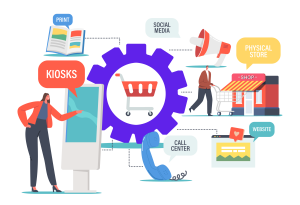
Benefits of Headless WordPress for Omnichannel eCommerce Experiences
Our Headless WordPress agency is aware that omnichannel experiences are becoming more and more complex due to the ever-growing customer demands. The good news is that eCommerce brands can secure their success by choosing a headless architecture for their high-traffic websites.
*Do you have a high-traffic website that’s in desperate need of a reliable hosting solution? Check out our expert picks for the best hosting companies for high-traffic WordPress websites!
In the next few points, we’ll go over some of the biggest benefits that headless WordPress can have for omnichannel eCommerce experiences. Read on!
1. Greater Customization Options
eCommerce brands should know that Headless WordPress development allows for the utilisation of API-driven microservices. This makes it possible to build a highly-effective eCommerce platform that is made of an ecosystem of best-in-breed components. The greatest thing, though, is that brands can leverage the power of custom development whenever necessary.
For instance, a company might wish to create a specific purchasing channel for bulk purchases across many locations. This necessitates some development tweaks as you’ll need custom pricing rules on bulk orders (oftentimes, this applies to certain items in various currencies).
Our Headless WordPress agency reminds you that legacy monolithic platforms have limitations that can be successfully overcome by a headless architecture. The additional custom development turns advancements and innovations into a doable endeavour.
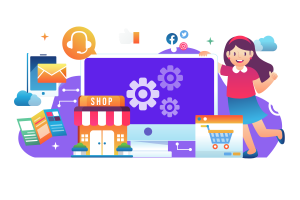
2. Innovative Customer Experiences
More and more brands are beginning to sell products through smart, connected devices. For instance, you might want to offer an IoT dishwasher that orders soap when it starts running out.
Headless WordPress development makes this possible since, with this architecture, you can create a front-end user experience that leverages APIs to access back-end data and conduct a transaction.
With headless WordPress, functionality like this can be developed and tested in a separate channel without interfering with other platform features. Then, if the tests turn out successful, you can implement the functionality on other devices.
3. Enhanced Resilience
The headless approach is perfect for brands that seek greater flexibility for their omnichannel strategy. A headless platform is the epitome of scalability since it is highly adaptable. This means that you can modify components when necessary and you can also substitute one microservice for another (or add a whole-new microservice).
Our Headless WordPress agency reminds you that this can be an excellent approach for meeting new customer needs. Remember that the main advantage of a headless architecture is that it can be scaled alongside your growing business. This makes it a future-proof solution for large-scale enterprise companies that run highly dynamic websites.
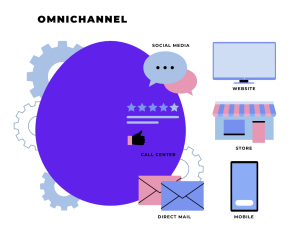
4. A Solid Back-End
Brands that offer Direct to Consumer (D2C) eCommerce services must provide their customers with various access points to their websites. What’s more, such companies need to maintain a consistent user experience across all access points. Thankfully, the headless architecture is the best method for deploying such solutions.
Since Headless WordPress development is an API-driven solution, it interacts seamlessly with the back-end platform to provide a consistent user experience for customers across all platforms.
*Do you want to learn more about APIs? Read our article “API-First Approach to WordPress Development” to find out how you can construct your entire website around APIs for maximum flexibility!
5. Content Consistency
A headless website architecture allows you to maintain consistency in your language and content across all channels. When you update something on the back-end, the APIs pick up the changes and display them on the appropriate panel.
*The headless approach goes hand in hand with the REST API functionality that is supported by WordPress. Learn what makes REST API the greatest superpower of WordPress and what are the applications of REST API in WooCommerce!
Our Headless WordPress agency reminds you that the headless architecture helps you deliver your brand message and content uniformly across all channels (this includes brand colours, logos, taglines, etc.).
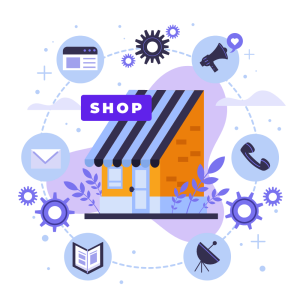
6. Focus On Your Business Growth
Headless WordPress development is a much better approach than, say, attempting to develop a proprietary CMS, OMS, or checkout feature for your eCommerce platform. By going headless, you can concentrate on what is essential to the success of your business since you’ll be constructing your eCommerce website with best-in-breed features that can be integrated from literally anywhere.
Best Practices for Using Headless WordPress to Develop a Successful Omnichannel Experience Strategy
Obviously, the very first thing you need to do in order to develop a successful omnichannel eCommerce platform is to find a reliable agency with highly-skilled developers who can bring the headless architecture to your existing website.
Apart from that, our Headless WordPress agency suggests you follow a few extra practices to ensure the success of your omnichannel eCommerce website. Check them out!
1. Know What Your Customers Like
Since Headless WordPress development is all about the pick-and-mix functionality, we recommend you do thorough research to understand your customers’ preferences. This will help you choose the right features that will be implemented in your headless website.
You can ask questions, provide options and even run polls and surveys to find out what your target audience likes and wants. This way, you’ll maintain their loyalty.
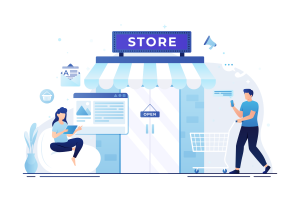
2. Choose the Appropriate Channels
Our Headless WordPress agency reminds you that not every channel will fit the tone of your eCommerce business. Selecting the right channels is absolutely crucial for the success of your omnichannel eCommerce platform. So make sure to pick the ones that best resonate with your brand’s vision.
3. Prioritise Security
Security is of utmost importance for eCommerce brands since it basically equals trustworthiness. Remember that winning back a devoted consumer after a data breach can be a rather difficult task.
This is why you should never compromise on security. To ensure the security of your platform’s touchpoints, our Headless WordPress agency advises you to build them with the latest best practices in mind. Also, don’t forget to keep them up to date.
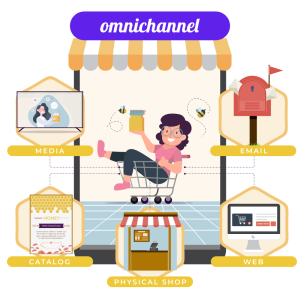
Headless WordPress Is the Perfect Solution for Omnichannel eCommerce!
And so, headless WordPress can be the perfect solution for eCommerce brands that want to provide omnichannel experiences to their customers. The best part is that a headless architecture allows you to scale your website as your business expands. With this approach, you can also rest assured that your branding will be preserved and maintained across all channels.
Since large-scale enterprise organisations usually have a lot on their plates, it is essential for them to choose a website architecture that can streamline processes. Our Headless WordPress agency knows that there are many online businesses with multiple separate eCommerce platforms that all have custom mobile applications. In this scenario, each store has a unique point-of-sale system. Just imagine how inconsistent the customer experience across all these different channels can be!
What’s more, people who are in charge of sustaining and improving those systems throughout time are burdened with tremendous responsibility. If the separate systems are radically dissimilar (e.g. developed in various programming languages and hosted in several geographical locations), the challenges only grow in scale. It should be clear how this might be a significant logistical difficulty if you’re attempting to use many technologies in an omnichannel environment.
With that being said, Headless WordPress development offers the best of both worlds. The headless architecture enables you to tailor and customise the customer experience while at the same time preserving and unifying the business logic that is unique to each unit, location, or channel.
More on The Topic
- Scaling WordPress Without Losing Culture
- WordPress 6.9 “Gene”: What This Release Really Changes
- Managing Gutenberg Chaos at Scale
- The Real Difference Between Managed and Developer-Oriented Hosting
- WordCamp Sofia 2025: A Full Recap of Bulgaria’s Biggest WordPress Event
Tags: apiecommerceeCommerce websiteheadless architectureheadless CMSHeadless WordPressHeadless WordPress developmentOmnichannelomnichannel eCommerceREST API
The content of this website is copyrighted and protected by Creative Commons 4.0.



